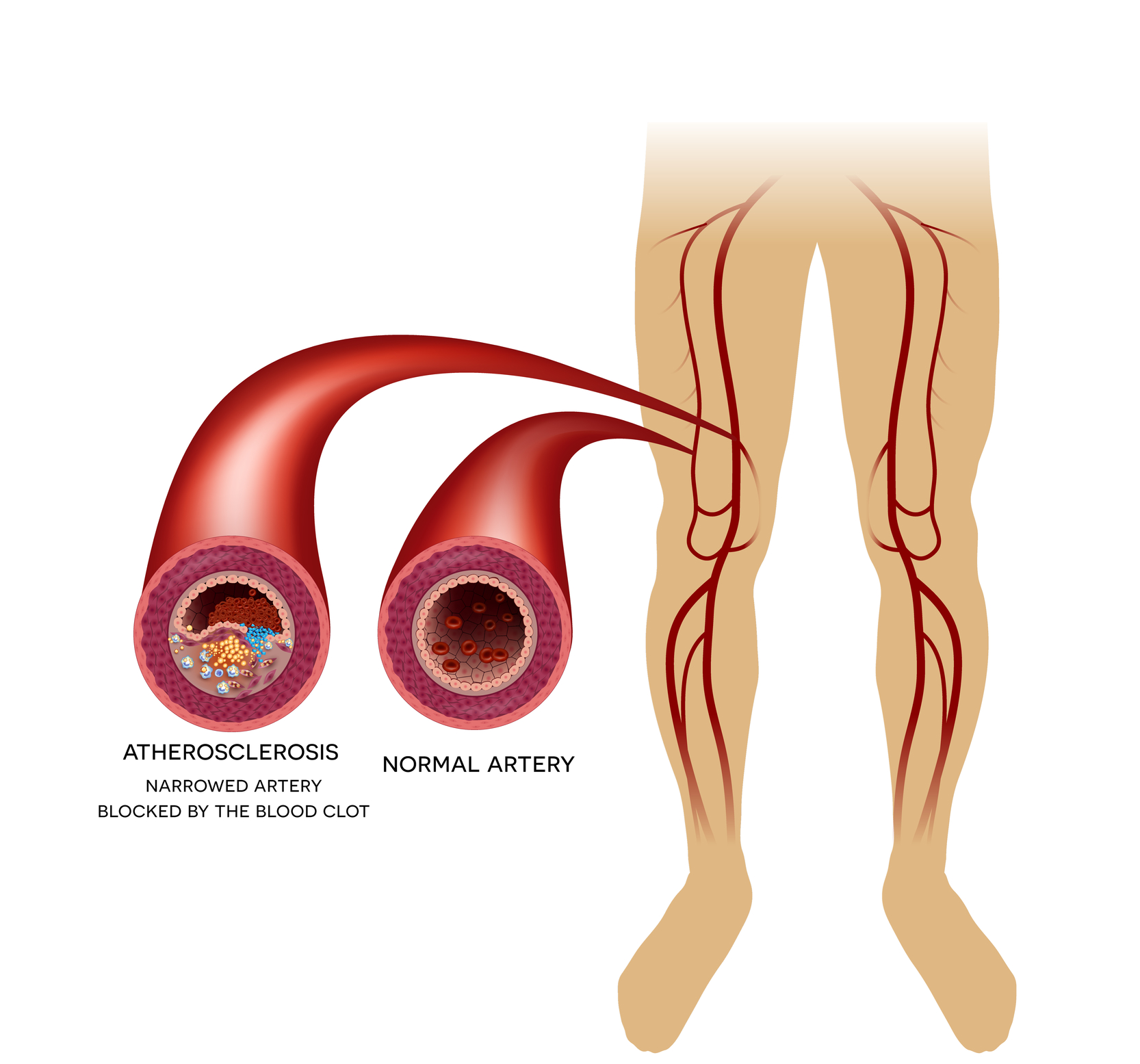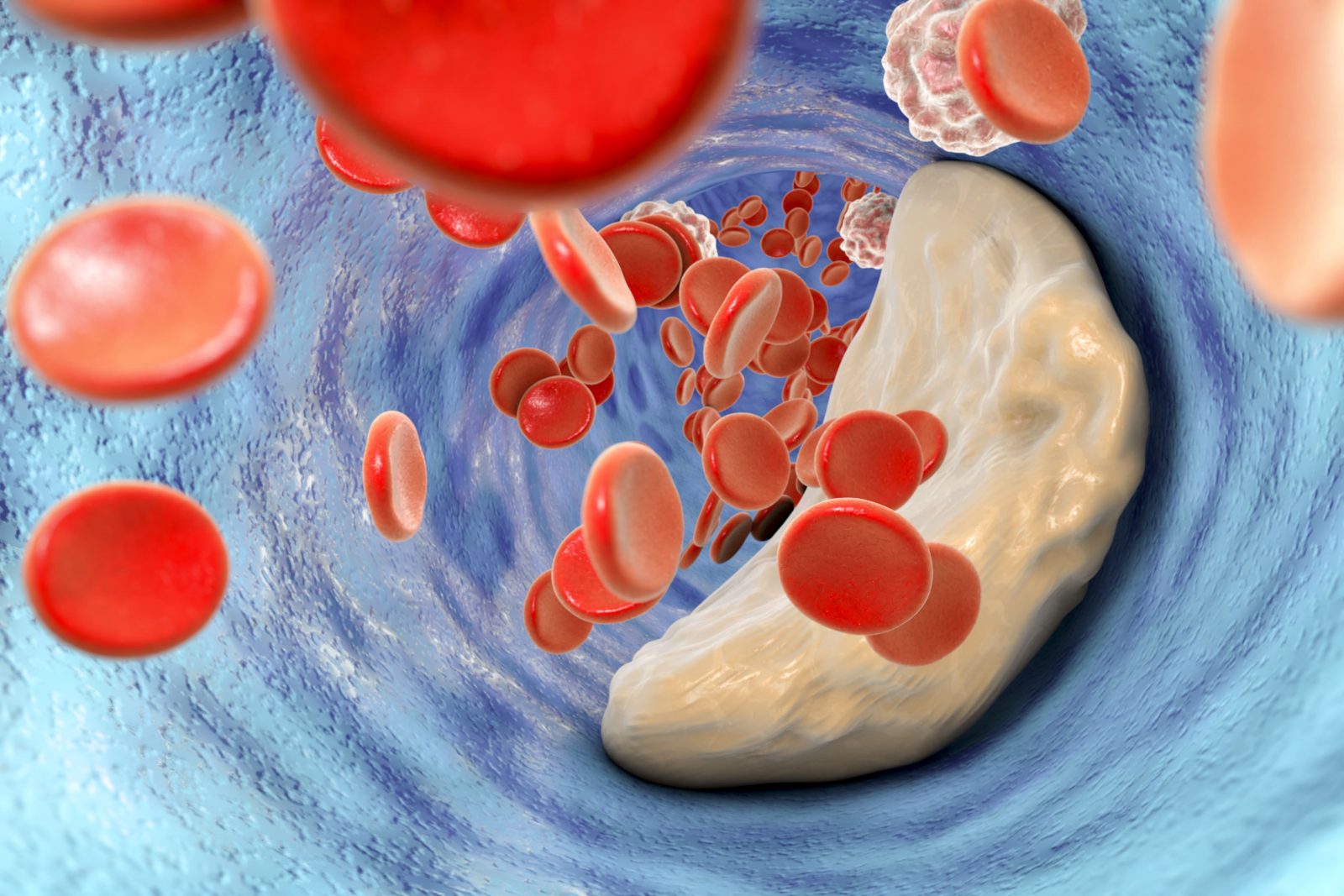
Peripheral Artery Disease

Peripheral artery disease (PAD) is a common circulatory problem caused by atherosclerosis. Atherosclerosis occurs when plaque builds up inside the walls of the arteries. This plaque is made up of deposits of fats, cholesterol, and other substances.
The narrowing of the arteries, just like crimping a garden hose, restricts flow (of blood in this case) to your legs. When there is not enough blood supply to an area of the body, that area is said to be “ischemic”.
This is the same process that leads to chest pain (known as “angina”) in the case of someone who is pre-heart attack. In the legs, we call this “claudication”, or pain with walking. As the restriction of blood flow becomes more severe, eventually a critical point is reached where the tissue can no longer survive.
In the case of the heart, this is called a “heart attack”, or “myocardial infarction”. In the brain, we know this as a “stroke”. In the legs, we call this “gangrene”.
Atherosclerosis and PAD
Plaque build-up over time narrows the arteries, which, as a result, chokes off blood flow. Sometimes that plaque becomes brittle or inflamed, leading to rupture, which can then result in a blood clot to form. A clot can lead to further narrowing of the artery or a complete blockage, causing a critical and sudden blockage.
If a blockage in the peripheral arteries of the legs remains untreated, it can cause pain, changes in skin color, difficulty walking and sores or ulcers. The loss of circulation to the legs and feet can cause gangrene and potentially result of the extremity needing to be amputated.
Peripheral Artery Disease has common symptoms, but many people with PAD have actually never had any symptoms at all.

How Is PAD Diagnosed & Treated?
There is no one specific test that will diagnose Peripheral Artery Disease. At Vivid Vascular, our team will perform a complete and thorough examination along with in-office diagnostic testing. Some of the tests we may rely on to diagnose peripheral artery disease include:
A PHYSICAL EXAM
A physical examination by your doctor may find signs of PAD such as a weak or absent pulse below a narrowed area of your artery, whooshing sounds (bruits) over your arteries that can be heard with a stethoscope, signs of poor healing wounds in areas where your blood flow is restricted, and decreased blood pressure in your affected limb.
ULTRASOUND
A Doppler ultrasound will allow us to evaluate blood flow through your blood vessels and identify any blocked or narrowed arteries.
ANKLE-BRACHIAL INDEX (ABI)
The ABI is a common test used to help diagnose PAD. The test compares the blood pressure in the ankle with the blood pressure in the arm. During the test, your doctor will use a regular blood pressure cuff and a special ultrasound device to evaluate blood pressure and flow. Your doctor may have you walk on a treadmill and so readings can be obtained before and immediately after exercising to capture the severity of the narrowed arteries during walking.
BLOOD TESTS
A sample of your blood can be used to measure your cholesterol and triglycerides and to check for diabetes.

Symptoms
- Painful cramping in your hip, thigh or calf muscles after activities like walking or climbing stairs
- Leg numbness or weakness
- Coldness in your lower leg or foot, especially when compared with the other side
- Sores that won’t heal on legs, feet, or toes
- A color change in your legs
- Hair loss or slower hair growth on your legs and feet
- Shiny skin on your legs
- Weak or no pulse in your legs or feet
- Can be associated with erectile dysfunction in men
- Your toenails start growing slower
- When advanced, causes constant leg pain even when you’re at rest or lying down
Risk Factors
- Smoking
- Diabetes
- Obesity
- High blood pressure
- High cholesterol
- Age, especially those 50+
- A family history of peripheral artery disease, heart disease or stroke

During an atherectomy (pictured here), we insert a special catheter with a sharp blade on the end to remove plaque from the blood vessel.
Treatment
The goal of treatment is to reopen the clogged arteries. We offer two different treatment options, both of which we perform in-office using a local anesthesia.
ANGIOPLASTY & STENTING
In this nonsurgical procedure, we use a catheter to insert a tiny balloon into your artery. Once in place, we inflate the balloon, which opens the artery for improved blood flow. We then insert a small, metal mesh tube – called a “stent” – into the artery to maintain the expansion and provide support inside the artery.
ATHERECTOMY
We perform this procedure using a special catheter, which we insert into the artery through a small puncture in the skin and artery. Using the catheter, we then remove the plaque and collect it into a chamber in the catheter’s tip, effectively decreasing/eliminating the blockage from the artery.
Make An Appointment Online
For your convenience, we now make it even easier for you to schedule your visit to Vivid Vascular by booking your appointment online. Simply select a date and time that is convenient for you and provide us with the requested information. One of our friendly patient care coordinators will reach out to you via your preferred contact method to confirm your appointment.
